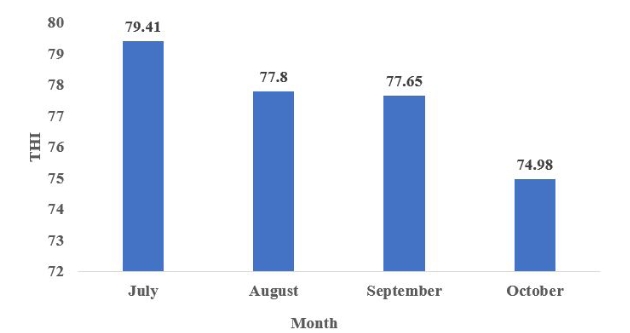Effect of dietary betaine on endocrine profile in postpartum lactating Murrah buffaloes during hot-humid season
DOI:
https://doi.org/10.56825/bufbu.2022.4144603Keywords:
Bubalus bubalis, buffaloes, betaine, thyroxine, estrogen, progesterone, cortisolAbstract
Extreme heat along with metabolic stress associated with the postpartum period negatively affects the endocrine status of animals. Betaine is a feed additive that promotes animal growth. Since betaine contains three methyl groups, it acts as a methyl donor in animal metabolism. Eighteen postpartum Murrah buffaloes were randomly divided into T1 Group (Control), T2 and T3 Group was supplemented with betaine 50 g/animal/day and 100 g/animal/day respectively from 5th day postpartum and was continued up to 4 months postpartum. On day 50 postpartum the mean value of plasma cortisol of T1 Group was maximum followed by T2 Group and T3 Group had minimum plasma cortisol mean value which differed (P<0.05) significantly between groups. The mean concentration of plasma T3 total, T4 total, progesterone and estrogen showed (P>0.05) non-significant difference between all the groups. However, betaine fed T2 and T3 Group had higher plasma T3, T4, progesterone and estrogen as compared to control, it might be due to the effect of betaine, which reduces metabolic stress and activate hypothalmo-pituitary and gonadal axis after parturition and lactation period during heat stress.
Downloads
Metrics
References
Christison, G.I. and H.D. Johnson. 1972. Cortisol turnover in heat-stressed cows. J. Anim. Sci., 35(5): 1005-1010. DOI: 10.2527/jas1972.3551005x
Crowe, M.A. 2008. Resumption of ovarian cyclicity in post-partum beef and dairy cows. Reprod. Domest. Anim., 43(5): 20-28. DOI: 10.1111/j.1439-0531.2008.01210.x
Deshpande, A., S.V. Singh, Y.M. Somagond, P. Sheoran, S. Naskar and V.P. Chahal. 2020. Physio-biochemical responses and growth performance of buffalo heifers to betaine supplementation during hot humid season under field conditions. Indian J. Anim. Sci., 90(3): 85-92.
Eissa, H., M. Ei-Belely, I. Ghoneim and O. Ezzo. 1995. Plasma progesterone, oestradiol-17β, oestrone sulphate, corticosteroids and a metabolite of PGF2α: evolution throughout pregnancy, before, during and after parturition in buffalo cows. BMC Vet. Res., 26(4): 310-318. Available on: https://hal.archives-ouvertes.fr/hal-00902354/document
FAO. 2011. Livestock in Food Security. Food and Agriculture Organization of the United Nations: FAO. Available on: http://www.fao.org/ docrep/014/i2373e/i2372e00.htm.
Fridman, O., A.V. Morales, L.E. Bortoni, P.C. Turk-Noceto and E.A. Prieto. 2012. Corticoadrenal activity in rat regulates betaine-homocysteine S-methyltransferase expression with opposite effects in liver and kidney. J. Bioscience, 37(1): 115-123. DOI: 10.1007/s12038-011-9171-5
Hussein, H.A., W. Senosy and M.R. Abdellah. 2013. Relationship among uterine involution, ovarian activity, blood metabolites and subsequent reproductive performance in egyptian buffaloes. Open Journal of Animal Sciences, 3(1): 59-69. DOI: 10.4236/ojas.2013.31009
ICAR. 2013. Nutrient Requirements of Cattle and Buffaloes. Indian Council of Agricultural Research, New Delhi, India.
Lakhani, P., P. Kumar, N. Lakhani and A. Bhimte. 2019. Effect of betaine supplementation on growth performance, nutrient intake and expression of IGF-1 in Karan Fries heifers during thermal stress. International Journal of Chemical Studies, 7(4): 533-541. DOI: 10.1016/j.theriogenology.2019.10.021
Mishra, A., A.K. Verma, A. Das, P. Singh and N.R. Sahoo. 2019. Effect of betaine supplementation on haematology, serum enzymes and hormone profile in gestating sows. Indian J. Anim. Sci., 89(5): 506-510.
Mondal, S., K.P. Suresh and S. Nandi. 2010. Endocrine profiles of oestrous cycle in buffalo: A meta-analysis. Asian Austral. J. Anim., 23(2): 169-174. DOI: 10.5713/ajas.2010.90193
NRC, 1971. A Guide to Environmental Research on Animals. National Academy of Science, Washington DC., USA.
Patton, J., D.A. Kenny, J.F. Mee, F.P. O’mara, D.C. Wathes, M. Cook and J.J. Murphy. 2006. Effect of milking frequency and diet on milk production, energy balance, and reproduction in dairy cows. J. Dairy. Sci., 89(5): 1478-1487. DOI: 10.3168/jds.S0022-0302(06)72215-9
Raheja, N., N. Kumar and S.S. Lathwal. 2019. Dietary betaine reduces incidence of follicular cyst in post-partum Karan Fries cows during hot-humid season. Indian J. Anim. Sci., 89(12): 1332-1337.
Savio, J.D., M.P. Boland, N. Hynes and J.F. Roche. 1990. Resumption of follicular activity in the early post-partum period of dairy cows. J. Reprod. Fertil., 88(2): 569-579. DOI: 10.1530/jrf.0.0880569
Schrama, J.W., M.J. Heetkamp, P.H. Simmins and W.J. Gerrits. 2003. Dietary betaine supplementation affects energy metabolism of pigs. J. Anim. Sci., 81(5): 1202-1209. DOI: 10.2527/2003.8151202x
Tiiratz, T. 1997. Thyroxine, triiodothyronine and reverse-triiodothyronine concentrations in blood plasma in relation to lactational stage, milk yield, energy and dietary protein intake in Estonian dairy cows. Acta Vet. Scand., 38: 339-348. DOI: 10.1186/BF03548480
Wolfenson, D., Z. Roth and R. Meidan, 2000. Impaired reproduction in heat-stressed cattle: Basic and applied aspects. Anim. Reprod. Sci., 60(61): 535-547. DOI: 10.1016/s0378-4320(00)00102-0
Zhang, L., S.J. Ying, W.J. An, H. Lian, G.B. Zhou and Z.Y. Han. 2014. Effects of dietary betaine supplementation subjected to heat stress on milk performances and physiology indices in dairy cow. Genet. Mol. Res., 13(3): 7577-7586. DOI: 10.4238/2014.September.12.25









.png)








